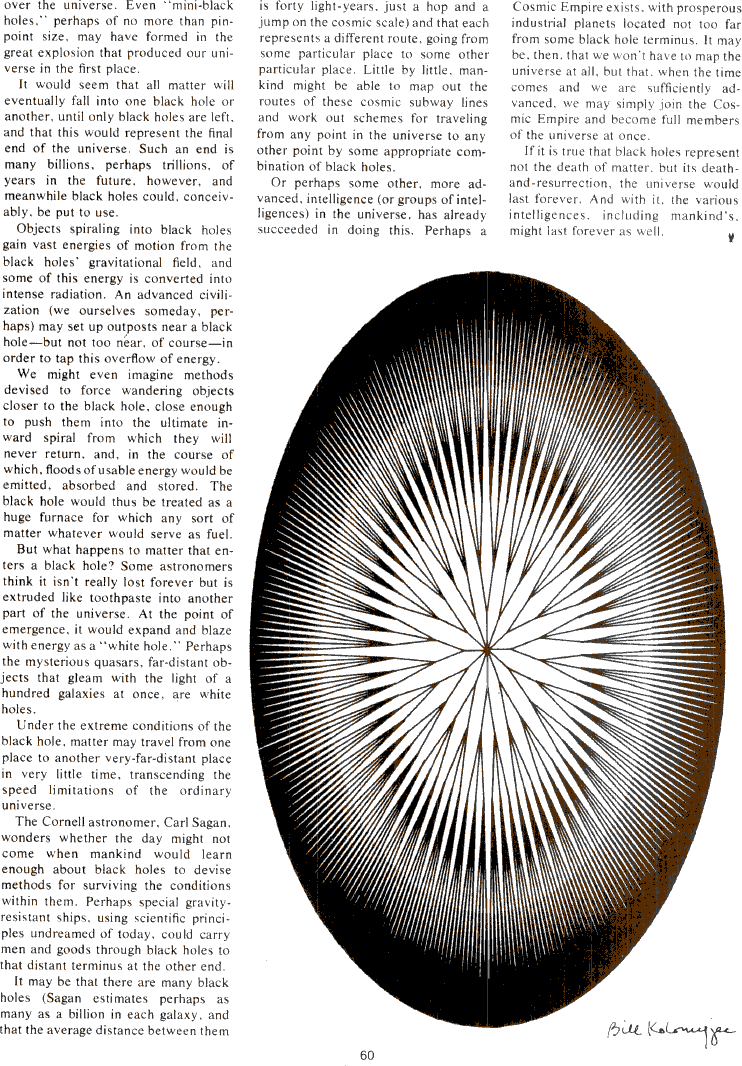The Best of Creative Computing Volume 2 (published 1977)
The Cosmic Subway Line (white holes, traveling through black holes, Carl Sagan)

over the universe. Even "mini-black holes." perhaps of no more than pinpoint
size, may have formed in the great explosion that produced our universe in the
first place.
It would seem that all matter will eventually fall into one black hole or
another, until only black holes are left, and that this would represent the
final end of the universe. Such an end is many billions, perhaps trillions, of
years in the future, however, and meanwhile black holes could, conceivably, be
put to use.
Objects spiraling into black holes gain vast energies of motion from the black
holes' gravitational field, and
some of this energy is converted into intense radiation. An advanced
civilization (we ourselves someday, perhaps) may set up outposts near a black
hole-but not too near, of course-in order to tap this overflow of energy.
We might even imagine methods devised to force wandering objects closer to the
black hole, close enough to push them into the ultimate inward spiral from which
they will never return. and. in the course of which, floods of usable energy
would be emitted, absorbed and stored. The black hole would thus be treated as a
huge furnace for which any sort of matter whatever would serve as fuel.
But what happens to matter that enters a black hole? Some astronomers think it
isn't really lost forever but is extruded like toothpaste into another part of
the universe. At the point of emergence, it would expand and blaze with energy
as a "white hole." Perhaps the mysterious quasars, far-distant objects that
gleam with the light of a hundred galaxies at once, are white holes.
Under the extreme conditions of the black hole, matter may travel from one place
to another very-far-distant place in very little time, transcending the speed
limitations of the ordinary universe.
The Cornell astronomer, Carl Sagan, wonders whether the day might not come when
mankind would learn enough about black holes to devise methods for surviving the
conditions within them. Perhaps special gravity-resistant ships, using
scientific principles undreamed of today, could carry men and goods through
black holes to that distant terminus at the other end.
It may be that there are many black holes (Sagan estimates perhaps as many as a
billion in each galaxy, and that the average distance between them is forty
light-years, just a hop and a jump on the cosmic scale) and that each represents
a different route. going from some particular place to some other particular
place. Little by little, mankind might be able to map out the routes of these
cosmic subway lines and work out schemes for traveling from any point in the
universe to any other point by some appropriate combination of black holes.
Or perhaps some other, more advanced, intelligence (or groups of intelligences)
in the universe, has already
succeeded in doing this. Perhaps a Cosmic Empire exists, with prosperous
industrial planets located not too far from some black hole terminus. It may be,
then, that we won't have to map the universe at all, but that, when the time
comes and we are sufficiently advanced, we may simply join the Cosmic Empire and
become full members of the universe at once.
If it is true that black holes represent not the death of matter, but its
death-and-resurrection, the universe would last forever. And with it, the
various intelligences, including mankind's, might last forever as well.


